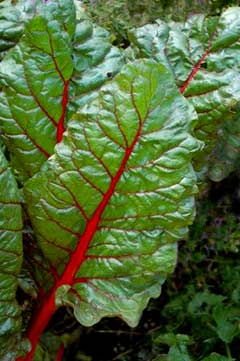PLANT NOTES - VEGETABLES
Swiss Chard
Family: Chenopodiaceae Genus and Species: Beta vulgaris cicla
Chard is easy to grow in Sacramento (zone 9) and can be grown all year. Chard is a hardy biennial which prefers cool weather. Chard comes in two types; one has a reddish stalk and the other a creamy white stalk. Chard will grow right through our hot summers as long as it is somewhat shaded. A large zucchini plant can provide good shade for chard.
Swiss chard is actually a beet that is grown for its tops. It is valuable in the garden as it sends down long, powerful roots that break up heavy subsoil and can tap into minerals deep below the surface. Chard seeds store for 3 years under good conditions.
Planting![]()
Chard likes rich, mellow soil, not acid, that is enriched with compost. Starters can be planted (usually available at local nurseries) or seed (soak for 24 hours) planted ½” deep and 2-4” apart in rows approx. 12” apart. Typically, chard germinates in 55-85°F soil temperatures in 6-10 days and takes 50-60 days to reach maturity.
Cultivation
Keep heavily mulched and moist. Provide partial shade. If harvested through winter and roots are kept alive, a spring crop can be anticipated. Chard may benefit from 1-2 applications of compost, compost tea, or 50/50 mix of liquid kelp (Maxicrop) and fish emulsion

Harvesting
Swiss chard can be picked as soon as the leaves are large enough to harvest, usually in four to six weeks. Thin plants when 6” tall, by removing every other plant. Use in salads or as (cooked) greens. When plants are about 7” tall, begin harvesting by cutting outer leaves with a sharp knife/pruners, or twist off. Allow inner small leaves to grow to continue harvesting all season. Greens are cooked like spinach. Both the stalk and the leaves are good to eat.
After harvesting, do not expose to direct sunlight. Cool chard immediately after harvesting to stop the quick deterioration from water loss and production of heat after harvest. Clean off any dirt and cool in cold water (hydro cooling), by spraying or immersing vegetables in the chilled water. Chard should be stored at 32°F and high humidity (98%-100%). In ideal conditions chard may last up to 2 weeks. Chard is sensitive to ethylene gases so do not store it with fruits and vegetables that produce ethylene gas (apple, peach, pear, cantaloupe).
Companions
Grow with nasturtiums and marigolds and large plants for shade (especially in summer). Do not plant chard near pole beans.
Commons Attribution 3.0 License